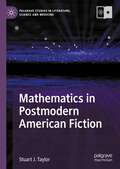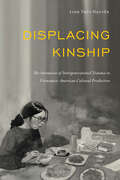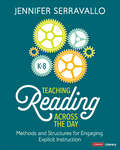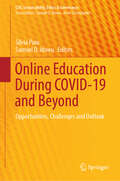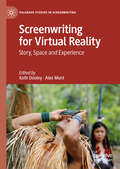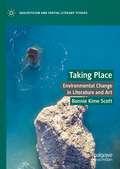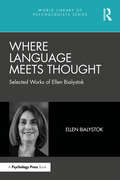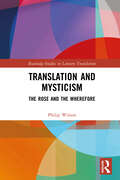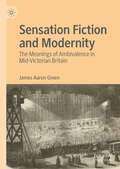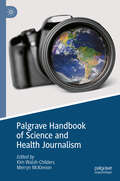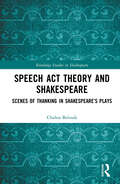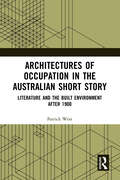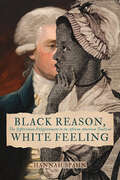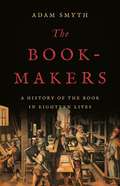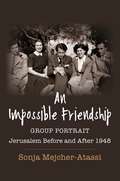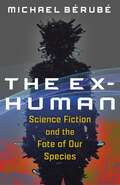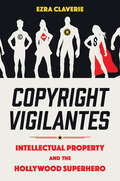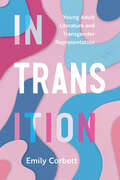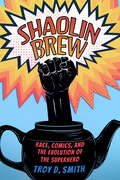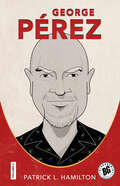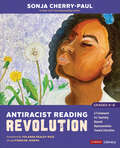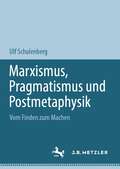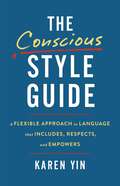- Table View
- List View
Mathematics in Postmodern American Fiction (Palgrave Studies in Literature, Science and Medicine)
by Stuart J. TaylorThis book delivers an innovative critical approach to better understand U.S. fiction of the information age, and argues that in the last eighty years, fiction has become increasingly concerned with its representations of mathematical ideas, images, and practices. In so doing, this book provides a fuller, transnational account of the place of mathematics in understanding mathematically informed novels. Literature and science studies have acknowledged and situated historical points of cultural crossover; by emphasising mathematics within this larger intellectual context – and not as an unlikely and alien adjunct to post-war culture – this monograph clarifies how mathematically informed postmodern fictions work in a cognate fashion to other fields undergoing structuralist revolutions. This is especially evident in fiction by the key, mathematically-literate Postmodern authors upon whom this study focuses, namely, Thomas Pynchon, Don DeLillo, and David Foster Wallace, through which recent the technological revolutions, facilitated by mathematics, manifest in cultural discourse.
Displacing Kinship: The Intimacies of Intergenerational Trauma in Vietnamese American Cultural Production (Asian American History & Cultu)
by Linh Thuy NguyenNearly fifty years after the end of the war in Vietnam, American children of Vietnamese refugees continue to process the meanings of the war and its consequences through creative work. Displacing Kinship examines how Vietnamese American cultural productions register lived experiences of racism in their depictions of family life and marginalization. Second-generation texts illustrate how the children of refugees from Vietnam are haunted by trauma and a violent, ever-present, but mostly unarticulated past. Linh Thủy Nguyễn's analysis reveals that present experiences of economic insecurity and racism also shape these narratives of familial loss. Developing a theory of intergenerational trauma, Nguyễn rethinks how U.S. imperialism, the discourse of communism, and assimilation impacted families across generations. Through ethnic studies and feminist and queer-of-color critique, Displacing Kinship offers a critical approach for reading family tensions and interpersonal conflict as affective investments informed by the material, structural conditions of white supremacy and racial capitalism.
Teaching Reading Across the Day, Grades K-8: Methods and Structures for Engaging, Explicit Instruction
by Jennifer Serravallo"Reading well across disciplines and within varied contexts will help students to be versatile, flexible, deep readers who can better learn from their reading, transfer skills across subjects, and use strategies to meet the unique demands of reading in each content area." – Jennifer Serravallo Research-based, easy-to-use lesson structures for explicit and engaging teaching In Teaching Reading Across the Day, literacy expert Jennifer Serravallo provides nine effective, predictable, research-based lesson structures that help busy teachers save planning time and focus their teaching—and student attention—on content rather than procedures. Each of the nine lesson structures (read aloud, phonics and spelling, vocabulary, focus, shared reading, close reading, guided inquiry, reader’s theater, and conversation) has its own chapter and features a wealth of resources that let you see the lessons in action in ELA, Science, and Social Studies classes, including: An annotated teaching vignette, lesson explanation, and research notes Tips for planning, structure and timing suggestions, and ideas for responsive teaching Detailed planning templates and 22 accompanying online videos covering over 3 hours of classroom footage Jen’s reflections, key look-fors, and ideas for next steps The nine lesson structures can be used with any curriculum or core program, text, and subject, making it easier for teachers to maximize explicit and engaging teaching time across the day, and simplify planning and preparation. Jen incorporates a wide range of compelling research about how best to teach reading to every student in your class and translates the research (or the science of teaching reading) into high-leverage moves you can count on to deliver powerful lessons again and again. She also honors the art of teaching reading, helping teachers tap into their experience and hone their expertise to make quick, effective classroom decisions that take student learning to the next level.
Teaching Reading Across the Day, Grades K-8: Methods and Structures for Engaging, Explicit Instruction
by Jennifer Serravallo"Reading well across disciplines and within varied contexts will help students to be versatile, flexible, deep readers who can better learn from their reading, transfer skills across subjects, and use strategies to meet the unique demands of reading in each content area." – Jennifer Serravallo Research-based, easy-to-use lesson structures for explicit and engaging teaching In Teaching Reading Across the Day, literacy expert Jennifer Serravallo provides nine effective, predictable, research-based lesson structures that help busy teachers save planning time and focus their teaching—and student attention—on content rather than procedures. Each of the nine lesson structures (read aloud, phonics and spelling, vocabulary, focus, shared reading, close reading, guided inquiry, reader’s theater, and conversation) has its own chapter and features a wealth of resources that let you see the lessons in action in ELA, Science, and Social Studies classes, including: An annotated teaching vignette, lesson explanation, and research notes Tips for planning, structure and timing suggestions, and ideas for responsive teaching Detailed planning templates and 22 accompanying online videos covering over 3 hours of classroom footage Jen’s reflections, key look-fors, and ideas for next steps The nine lesson structures can be used with any curriculum or core program, text, and subject, making it easier for teachers to maximize explicit and engaging teaching time across the day, and simplify planning and preparation. Jen incorporates a wide range of compelling research about how best to teach reading to every student in your class and translates the research (or the science of teaching reading) into high-leverage moves you can count on to deliver powerful lessons again and again. She also honors the art of teaching reading, helping teachers tap into their experience and hone their expertise to make quick, effective classroom decisions that take student learning to the next level.
Online Education During COVID-19 and Beyond: Opportunities, Challenges and Outlook (CSR, Sustainability, Ethics & Governance)
by Samuel O. Idowu Silvia PuiuThis book aims to provide sustainable solutions for better understanding and management of online education in different parts of the world. In this context, it explores the attitudes and perceptions of stakeholders, such as students, faculty, and other actors on issues related to online education. In particular, it examines the challenges they have faced over the years when online courses were introduced due to the COVID-19 pandemic. A model is proposed that includes five variables: specific communication issues in online education, the ability of professors to offer online courses, the quality of online education, students' perceived stress during online education, and the technical requirements of online education.The book will be of interest to anyone concerned with the new and future ways of teaching and learning.Chapter “When a Phenomenon-Based University Course Went Online: Students’ Experiences and Reflections After Sauna Bathing” is available open access under a Creative Commons Attribution 4.0 International License via link.springer.com.
Screenwriting for Virtual Reality: Story, Space and Experience (Palgrave Studies in Screenwriting)
by Kath Dooley Alex MuntThis book is focused on screenwriting and development for virtual reality (VR). It explores a diverse range of creative approaches to the writing and screen development of VR stories and immersive audience experiences. Contributions from scholars and practitioners combine conceptual and practically orientated approaches for creating fictional and documentary media VR stories. The book evaluates, challenges and adapts existing screenwriting models and practices for immersive storytelling and grapples with the future of storytelling in the era of sophisticated computer visualization, AI and the online social metaverse. The book proposes new VR storytelling models, identifies altered relationships between creators, screen works and their audiences and demonstrates how interdisciplinary practices will be core to the future of screen storytelling.
Taking Place: Environmental Change in Literature and Art (Geocriticism and Spatial Literary Studies)
by Bonnie Kime ScottTaking Place: Environmental Change in Literature and Art explores how works of literature and art help us to rethink the ways that we have perceived, imagined, inhabited, explored, conquered, and shared places. The book offers chapters on India, Southern Africa, Ireland, Australia, and New York City. The literary and artistic works investigated range in time from early indigenous rock art to contemporary literary representations of place. Bonnie Kime Scott participates in ongoing interdisciplinary discussions of ecocritical, feminist, postcolonial, post-humanist and place studies.
Where Language Meets Thought: Selected Works of Ellen Bialystok (World Library of Psychologists)
by Ellen BialystokIn the World Library of Psychologists series, international experts present career-long collections of what they judge to be their most interesting publications – extracts from books, key articles, research findings, and practical and theoretical contributions.Ellen Bialystok has published widely in the field of cognitive development and decline across the lifespan. Her research uses behavioral and neuroimaging methods to examine the effect of experience on cognitive and brain systems with a focus on bilingualism. Her discoveries include the identification of differences in the development of cognitive and language abilities for monolingual and bilingual children, the use of different brain networks by monolingual and bilingual young adults performing cognitive tasks, and the postponement of symptoms of dementia in bilingual older adults. In other studies, she has investigated the effects of bilingual education on children’s development and the cognitive and brain consequences of bilingualism in older adults.Including a specially written introduction, in which Ellen Bialystok reflects on the role that language plays on thought, this collection will serve as a valuable resource for students and researchers of psycholinguistics, developmental psychology, and applied linguistics.
Translation and Mysticism: The Rose and the Wherefore (Routledge Studies in Literary Translation)
by Philip WilsonThis book examines how mysticism can tell us about translation and translation can tell us about mysticism, addressing the ancient but ongoing connections between the art of rendering one text in another language and the art of the ineffable.The volume represents the first sustained act of attention to the interdisciplinary crossover of these two fields, taking a Wittgensteinian approach to language, and investigates how mystics and their translators manage to write about what cannot be written about. Three questions are addressed overall: how mysticism can be used to conceptualise translation; the issues that mysticism raises for translation theory and practice; and how mystical texts have been and might be translated. Walter Benjamin’s ‘The Translator’s Task’ is considered in detail as a controversial example of dialogue. Translation examples are given in a range of languages, and six major case studies are provided, including a close reading of Exodus and an analysis of a recent radical translation of Lucretius. This book will be of interest to students and researchers in translation studies, mysticism studies, theology and literary translation, as well as practising translators.
Sensation Fiction and Modernity: The Meanings of Ambivalence in Mid-Victorian Britain
by James Aaron GreenThis book re-reads the relationship between the Victorian sensation novel and modernity. Whereas critics have long recognized its appearance in the form of nervous subjects and technologically-enabled mobility, Green contends that sensation fiction also depicts modernity in the form of intellectual and moral discontinuity. Through closely historicist readings of novels by Wilkie Collins and Mary Elizabeth Braddon, as well as by Joseph Sheridan Le Fanu and Rhoda Broughton, this book traces how discontinuity is manifested in the suspenseful plotting of these fictions, through which readers are challenged to revise conventional assumptions about the world and adopt more contingent perspectives. The study demonstrates that reading for this sense of modernity does not merely uncover the genre's engagements with various mid-century contexts. More fundamentally, it broaches a new sense of the function and significance of sensation fiction: the acclimatization of its readers to the discontinuities of modern existence.
Palgrave Handbook of Science and Health Journalism
by Kim Walsh-Childers Merryn McKinnonThis handbook reviews the extant literature on the most important issues in health and science journalism, with a focus on summarizing the relevant research and identifying key questions that are yet to be answered. It explores challenges and best practices in health and science reporting, formats and audiences, key topics such as climate change, pandemics and space science, and the ethics and political impacts of science and health journalist practice. With numerous international contributions, it provides a comprehensive overview of an emerging area of journalism studies and science communication.
Speech Act Theory and Shakespeare: Scenes of Thanking in Shakespeare’s Plays (Routledge Studies in Shakespeare)
by Chahra BeloufaSpeech Act Theory and Shakespeare delves deeper than linguistic ornamentation to illuminate the complex dynamics of thanking as a significant speech act in Shakespearean plays. The word “thanks” appears nearly 400 times in 37 Shakespearean plays, calling for a careful investigation of its veracity as a speech act in the 16th-century setting. This volume combines linguistic analysis to explore the various uses of thanks, focusing on key thanking scenes across a spectrum of plays, including All’s Well That Ends Well, Romeo and Juliet, The Merchant of Venice, Timon of Athens, The Winter’s Tale, and the Henriad. Shakespeare’s works indicate the act of thanking to be more than a normal part of dialogue; it is an artistic expression fraught with pitfalls similar to those of negative speech acts. The study aims to determine what compels the characters in Shakespeare to offer thanks and evaluates Shakespeare’s accomplishment in imbuing the word “thanks” with performance quality in the theatrical sphere. This work adds to our comprehension of Shakespearean plays and larger conversations on the challenges of language usage in theatrical and cultural settings by examining the convergence of gratitude with power dynamics, political intrigue, and interpersonal relationships, drawing on a multidisciplinary approach that includes pragmatics, philosophy, religion, and psychology.
Architectures of Occupation in the Australian Short Story: Literature and the Built Environment after 1900
by Patrick WestPatrick West’s Architectures of Occupation in the Australian Short Story cultivates the potential for literary representations of architectural space to contribute to the development of a contemporary politics of Australian post-colonialism.West argues that the predominance of tropes of place within cultural and critical expressions of Australian post-colonialism should be re-balanced through attention to spatial strategies of anti-colonial power. To elaborate the raw material of such strategies, West develops interdisciplinary close readings of keynote stories within three female-authored, pan-twentieth century, Australian short-story collections: Bush Studies by Barbara Baynton (1902); Kiss on the Lips and Other Stories by Katharine Susannah Prichard (1932); and White Turtle: A Collection of Short Stories by Merlinda Bobis (1999). The capacity of the short-story form to prompt creative and politically germinal engagements with species of space associated with architecture and buildings is underscored. Relatedly, West argues that the recent resurgence of binary thought—on local, national, and international scales—occasions an approach to the short-story collections shaped by binary relationships like a dichotomy of inside and outside. Concluding his argument, West connects the literary and architectural critiques of the story collections to the wicked problem, linked to ongoing colonial violences, of improving Australian Indigenous housing outcomes.Innovative and interdisciplinary, this book will be of interest to scholars and students of Literary, Architectural, and Postcolonial Studies. .
Black Reason, White Feeling: The Jeffersonian Enlightenment in the African American Tradition (Jeffersonian America)
by Hannah SpahnThe vital influence of Black American intellectuals on the legacy of Thomas Jefferson&’s ideas The lofty Enlightenment principles articulated by Thomas Jefferson in the Declaration of Independence, so central to conceptions of the American founding, did not emerge fully formed as a coherent set of ideas in the eighteenth century. As Hannah Spahn argues in this important book, no group had a more profound influence on their development and reception than Black intellectuals. The rationalism and universalism most associated with Jefferson today, she shows, actually sprang from critical engagements with his thought by writers such as David Walker, Lemuel Haynes, Frederick Douglass, and W. E. B. Du Bois.Black Reason, White Feeling illuminates the philosophical innovations that these and other Black intellectuals made to build on Jefferson&’s thought, shaping both Jefferson&’s historical image and the exalted legacy of his ideas in American culture. It is not just the first book-length history of Jefferson&’s philosophy in Black thought; it is also the first history of the American Enlightenment that centers the originality and decisive impact of the Black tradition.
The Book-Makers: A History of the Book in Eighteen Lives
by Adam SmythA scholar and bookmaker &“breathes both books-as-objects and their creators back into life&” (Financial Times) in this five-hundred-year history of printed books, told through the people who created them Books tell all kinds of stories—romances, tragedies, comedies—but if we learn to read the signs correctly, they can tell us the story of their own making too. The Book-Makers offers a new way into the story of Western culture&’s most important object, the book, through dynamic portraits of eighteen individuals who helped to define it. Books have transformed humankind by enabling authors to create, document, and entertain. Yet we know little about the individuals who brought these fascinating objects into existence and of those who first experimented in the art of printing, design, and binding. Who were the renegade book-makers who changed the course of history? From Wynkyn de Worde&’s printing of fifteenth-century bestsellers to Nancy Cunard&’s avant-garde pamphlets produced on her small press in Normandy, this is a celebration of the book with the people put back in.
An Impossible Friendship: Group Portrait, Jerusalem Before and After 1948 (Religion, Culture, and Public Life #47)
by Sonja Mejcher-AtassiIn Jerusalem, as World War II was coming to an end, an extraordinary circle of friends began to meet at the bar of the King David Hotel. This group of aspiring artists, writers, and intellectuals—among them Wolfgang Hildesheimer, Jabra Ibrahim Jabra, Sally Kassab, Walid Khalidi, and Rasha Salam, some of whom would go on to become acclaimed authors, scholars, and critics—came together across religious lines in a fleeting moment of possibility within a troubled history. What brought these Muslim, Jewish, and Christian friends together, and what became of them in the aftermath of 1948, the year of the creation of the State of Israel and the Palestinian Nakba?Sonja Mejcher-Atassi tells the story of this unlikely friendship and in so doing offers an intimate cultural and social history of Palestine in the critical postwar period. She vividly reconstructs the vanished social world of these protagonists, tracing the connections between the specificity of individual lives and the larger contexts in which they are embedded. In exploring this ecumenical friendship and its artistic, literary, and intellectual legacies, Mejcher-Atassi demonstrates how social biography can provide a picture of the past that is at once more inclusive and more personal. This group portrait, she argues, allows us to glimpse alternative possibilities that exist within and alongside the fraught history of Israel/Palestine. Bringing a remarkable era to life through archival research and nuanced interdisciplinary scholarship, An Impossible Friendship unearths prospects for historical reconciliation, solidarity, and justice.
The Ex-Human: Science Fiction and the Fate of Our Species
by Michael BérubéFacing threats like climate change and nuclear warfare, science fiction authors have conjured apocalyptic scenarios of human extinction. Can such gloomy fates help us make sense of our contemporary crises? How important is the survival of our species if we wind up battling for an Earth that has become an unhabitable hellscape? What other possible futures do narratives of the end of humanity allow us to imagine?Michael Bérubé explores the surprising insights of classic and contemporary works of SF that depict civilizational collapse and contemplate the fate of Homo sapiens. In a lively, conversational style, he considers novels by writers including Ursula K. Le Guin, Margaret Atwood, Liu Cixin, Philip K. Dick, and Octavia Butler, as well as films that feature hostile artificial intelligence, such as 2001: A Space Odyssey, Blade Runner, and the Terminator and Matrix franchises. Bérubé argues that these works portray a future in which we have become able to see ourselves from the vantage point of something other than the human. Though framed by the possibility of human extinction, they are driven by a vision of the “ex-human”—a desire to imagine that another species is possible. For all science fiction readers worried about the fate of humanity, The Ex-Human is an entertaining yet sobering account of how key novels and films envision the world without us.
Copyright Vigilantes: Intellectual Property and the Hollywood Superhero
by Ezra ClaverieCopyright Vigilantes: Intellectual Property and the Hollywood Superhero explains superhero blockbusters as allegories of intellectual property relations. In movies based on characters owned by the comics duopoly of DC and Marvel, no narrative recurs more often than a villain’s attempt to copy the superhero's unique powers. In this volume, author Ezra Claverie explains this fixation as a symptom of the films’ mode of production. Since the 1930s, the dominant American comics publishers have treated the creations of artists and writers as work for hire, such that stories and characters become company property. Thus, publishers avoided sharing the profits both from magazine sales and from licensing characters into other media. For decades, creators have challenged this regime, demanding either shares of profits or outright ownership of their creations. Now that the duopoly rents, licenses, and adapts superheroes for increasingly expensive franchises, and for growing international audiences, any challenge to intellectual property relations threatens a production regime worth billions of dollars. Duopoly movies, therefore, present any attempt to break the superhero’s monopoly on their powers as the scheme of terrorists, mad scientists, or space Nazis—assuaging studio anxieties and revealing the fears of those who benefit most from the real-world ownership of superheroes. Weaving together legal analysis, Marxist political economy, and close readings of movies, Copyright Vigilantes explains the preoccupations of Hollywood’s leading genre.
In Transition: Young Adult Literature and Transgender Representation (Children's Literature Association Series)
by Emily CorbettThe first book-length work of its kind, In Transition: Young Adult Literature and Transgender Representation examines the shift in the young adult book market towards increased representation of transgender characters and authors. Through a comprehensive exploration of historical conventions, genres, character diversity, and ideologies of trans representation, Emily Corbett traces the roots of trans literature from its beginnings in a cisgender-dominated publishing world to the recent rise in trans creators, characters, and implied readers. Corbett describes how trans-ness was initially perceived as an issue to be overcome by cisgender authors and highlights the ways in which the market has changed.Through careful analysis of texts that have until now received little scholarly attention, Corbett weaves together different theoretical approaches and fields of study to provide a map of the textual and cultural histories of this twenty-first-century publishing phenomenon. Focusing on trans authorship, authentic storytelling, and intersectional diversity, this book charts changing public attitudes, the YA book market, and the unique sociocultural moment in which these books are published. In Transition contributes new perspectives on the intersections of adolescence and trans-ness and sheds light on a dynamic subset of YA literature that has yet to receive sustained analysis.
Shaolin Brew: Race, Comics, and the Evolution of the Superhero
by Troy D. SmithShaolin Brew: Race, Comics, and the Evolution of the Superhero looks at how the comic book industry developed from a white perspective and how minority characters were and are viewed through a stereotypical white gaze. Further, the book explores how voices of color have launched a shift in the industry, taking nonwhite characters who were originally viewed through a white lens and situating them outside the framework of whiteness. The financial success of Blaxploitation and Kung Fu films in the early 1970s led to major comics publishers creating, for the first time, Black and Asian superhero characters who headlined their own comics. The introduction of Black and Asian main characters, who previously only served as guest stars or sidekicks, launched a new kind of engagement between comics companies and minority characters and readers. However, scripted as they were by white writers, these characters were mired in stereotypes. Author Troy D. Smith focuses on Asian, Black, and Latinx representation in the comic industry and how it has evolved over the years. Smith explores topics that include Orientalism, whitewashing, Black respectability politics, the model minority myth, and political controversies facing fandoms. In particular, Smith examines how fans take the superheroes they grew up with—such as Luke Cage, Black Lightning, and Shang Chi—and turn them into the characters they wished they had as children. Shaolin Brew delves into the efforts of fans of color who urged creators to make these characters more realistic. This refining process increased as more writers and artists of color broke into the industry, bringing their own perspectives to the characters. As many of these characters transitioned from page to screen, a new generation of writers, artists, and readers have cooperated to evolve one-dimensional stereotypes into multifaceted, dynamic heroes.
George Pérez (Biographix #6)
by Patrick L. HamiltonBorn in the South Bronx to Puerto Rican parents, artist and writer George Pérez (1954–2022) cut his teeth in the 1970s as an artist at Marvel who worked on lesser titles like The Deadly Hands of Kung Fu and Creatures on the Loose, and then mainstays like Fantastic Four and The Avengers. In the 1980s, Pérez jumped ship to DC where he helped turn The New Teen Titans into a top-selling title and cocreated Crisis on Infinite Earths, which marked the publisher’s fiftieth anniversary and consolidated its sprawling universe. As writer and artist, Pérez relaunched DC’s Wonder Woman, a run that later inspired much of the 2017 film.Though Pérez’s style is highly recognizable, his contributions to comic art and history have not been fully acknowledged. In George Pérez, author Patrick L. Hamilton addresses this neglect, first, by discussing Pérez’s artistic style within the context of Bronze Age superhero art, and second, by analyzing Pérez’s work for its representations of race, disability, and gender. Though he struggled with deadlines and health issues in the 1990s, Pérez would reintroduce himself and his work to a new generation of comics fans with a return to Marvel’s The Avengers, as well as attempts at various creator-owned comics, the last of these being Sirens from Boom! Studios in 2014. Throughout his career, Pérez established a dynamic and minutely detailed style of comic art that was both unique and influential.
Antiracist Reading Revolution [Grades K-8]: A Framework for Teaching Beyond Representation Toward Liberation (Corwin Literacy)
by Sonja Cherry-Paul"When can we move beyond representation to liberation?" This question from a young Black girl moved New York Times #1 bestselling author Dr. Sonja Cherry-Paul to offer a vision for antiracist teaching that goes far beyond adding diverse texts in a classroom library. Antiracist Reading Revolution provides an actionable antiracist teaching framework and models how K-8 educators can create opportunities for transformative reading and discussions in classrooms. Dr. Cherry-Paul offers six critical lenses that help educators to adopt an antiracist teaching stance, spotlighting the importance of instruction built around love, joy, community, justice, and solidarity. Educators are invited to reflect on their instructional practices, dismantle ideologies that are barriers to students’ critical and creative thinking and cultivate identity-inspiring learning experiences where students can show up fully as themselves and recognize the full humanity of all people. This is what it means to move beyond representation to liberation. Chapters feature several children’s books that center BIPOC characters and creators. Dr. Cherry-Paul provides prompts and pathways for each children’s book that guide teachers toward putting into action the six critical lenses at the core of the Antiracist Reading Framework – affirmation, awareness, authorship, atmosphere, activism, and accountability. And she provides toolkits for students and teachers to use when selecting and reading books on their own. Chapters in this book also … Offer personal and insightful anecdotes, supported by research and scholarship, that illustrate the power of antiracist teaching in working toward equity, justice, and freedom Provide a clear and actionable guide for K-8 literacy educators including classroom teachers, instructional coaches, and librarians Encourage critical reflection, pausing to ask educators to examine their own identities and values, and how these influence their teaching Guide educators toward selecting and teaching with books that center the lived experiences of BIPOC students This book is a call to action. In Dr. Cherry-Paul’s words, "In an antiracist classroom, reading helps us to dream, experience joy, engage in collective struggle, liberate our minds, and love. Let’s move forward together to realize our vision of an antiracist reading classroom rooted in love and liberation."
Antiracist Reading Revolution [Grades K-8]: A Framework for Teaching Beyond Representation Toward Liberation (Corwin Literacy)
by Sonja Cherry-Paul"When can we move beyond representation to liberation?" This question from a young Black girl moved New York Times #1 bestselling author Dr. Sonja Cherry-Paul to offer a vision for antiracist teaching that goes far beyond adding diverse texts in a classroom library. Antiracist Reading Revolution provides an actionable antiracist teaching framework and models how K-8 educators can create opportunities for transformative reading and discussions in classrooms. Dr. Cherry-Paul offers six critical lenses that help educators to adopt an antiracist teaching stance, spotlighting the importance of instruction built around love, joy, community, justice, and solidarity. Educators are invited to reflect on their instructional practices, dismantle ideologies that are barriers to students’ critical and creative thinking and cultivate identity-inspiring learning experiences where students can show up fully as themselves and recognize the full humanity of all people. This is what it means to move beyond representation to liberation. Chapters feature several children’s books that center BIPOC characters and creators. Dr. Cherry-Paul provides prompts and pathways for each children’s book that guide teachers toward putting into action the six critical lenses at the core of the Antiracist Reading Framework – affirmation, awareness, authorship, atmosphere, activism, and accountability. And she provides toolkits for students and teachers to use when selecting and reading books on their own. Chapters in this book also … Offer personal and insightful anecdotes, supported by research and scholarship, that illustrate the power of antiracist teaching in working toward equity, justice, and freedom Provide a clear and actionable guide for K-8 literacy educators including classroom teachers, instructional coaches, and librarians Encourage critical reflection, pausing to ask educators to examine their own identities and values, and how these influence their teaching Guide educators toward selecting and teaching with books that center the lived experiences of BIPOC students This book is a call to action. In Dr. Cherry-Paul’s words, "In an antiracist classroom, reading helps us to dream, experience joy, engage in collective struggle, liberate our minds, and love. Let’s move forward together to realize our vision of an antiracist reading classroom rooted in love and liberation."
Marxismus, Pragmatismus und Postmetaphysik: Vom Finden zum Machen
by Ulf SchulenbergVom Finden zum Machen bietet die erste ausführliche Diskussion über die Beziehung zwischen Marxismus und Pragmatismus. Diese beiden Philosophien der Praxis sind nicht unvereinbar, und eine Analyse ihrer Beziehung hilft, beide besser zu verstehen. Im Rahmen eines transatlantischen theoretischen Dialogs werden in diesem Buch Gemeinsamkeiten und Unterschiede zwischen diesen Philosophien erörtert. Es handelt sich um eine interdisziplinäre Studie, die Philosophie, amerikanische und europäische Geistesgeschichte und Literaturwissenschaft zusammenführt. Schulenbergs Buch zeigt, dass der Versuch, die Dialektik von Marxismus und Pragmatismus zu erhellen, ein guter Ausgangspunkt ist, wenn wir das unvollendete Projekt der Etablierung einer wirklich postmetaphysischen Kultur weiterführen wollen. Das Buch bietet detaillierte Diskussionen über Sidney Hook, Georg Lukács, Theodor W. Adorno, Fredric Jameson, W.E.B. Du Bois, John Dewey, Richard Rorty und Jacques Rancière.Die Übersetzung wurde mit Hilfe von künstlicher Intelligenz durchgeführt. Eine anschließende menschliche Überarbeitung erfolgte vor allem in Bezug auf den Inhalt.
The Conscious Style Guide: A Flexible Approach to Language That Includes, Respects, and Empowers
by Karen YinA timeless, indispensable guide for anyone who wants to communicate with sensitivity and compassion. Most of us want to choose inclusive, respectful, and empowering language. But language—and how we use it—continually evolves, along with cultural norms. When contradictory opinions muddle our purpose, how do we align our word choices with our beliefs? Who has the final say when people disagree? And why is it so hard to let go of certain words? Afraid of getting something wrong or offending, we too often treat words as dos or don&’ts, regardless of context and nuance. Thankfully, in The Conscious Style Guide, award-winning editor Karen Yin provides a road map for writing and speaking with equity in mind—no matter how the world around us changes. Readers will learn: How to identify biased language How to use inclusive language to bring attention to specific groups of people How to adopt conscious language as a tool for self-awareness and critical thinking How to make digital materials more accessible, from event flyers to websites How to alleviate the stress of experiencing exclusionary language How to collaborate with others and work across differences How to create a style sheet to help support your practice And much more With practical advice and hundreds of relatable examples, The Conscious Style Guide invites us to challenge binary thinking, embrace flexibility and creativity, and explore truly effective communication—in all aspects of our lives.
